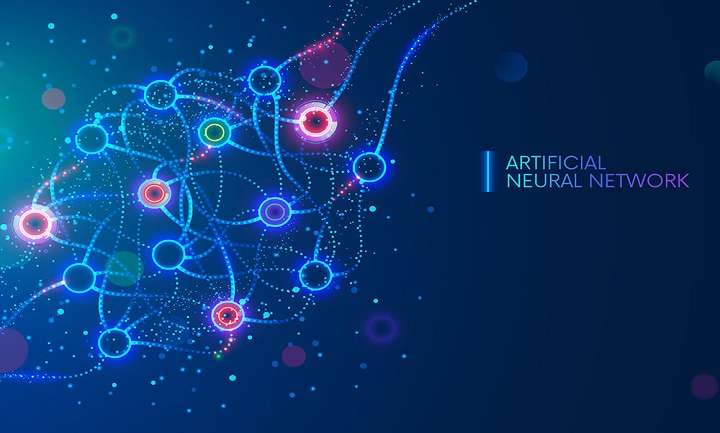Importance of Artificial Neural Networks in Artificial Intelligence
Artificial Neural Networks

Artificial Neural Networks (ANNs) play a crucial role in the field of Artificial Intelligence (AI). They are modeled
after the structure and function of the human brain and are used to solve complex problems in a manner similar to the way the human brain would.
ANNs are used in a wide range of applications, including image recognition, speech recognition, natural language processing, and decision-making. They can be used to classify images, transcribe speech into text, understand and generate natural language, and make decisions based on input data.
One of the key advantages of ANNs is their ability to learn from data. They can be trained on a large dataset and then used to make predictions or classifications based on new input data. This makes them useful for tasks that would be difficult or impossible for traditional computer programs to perform.
Another advantage of ANNs is their ability to generalize from examples. They can identify patterns in the training data and use this knowledge to make predictions on new, unseen data. This ability to generalize makes them highly useful for a wide range of tasks, from image classification to autonomous decision-making.
In conclusion, ANNs play a significant role in AI due to their ability to learn from data, generalize from examples, and solve complex problems in a manner similar to the human brain. They are widely used in a variety of applications and continue to play an important role in advancing the field of AI.
1. What is artificial neural networks?
Artificial Neural Networks (ANNs) are computational models inspired by the structure and function of the human brain. They consist of interconnected nodes, called artificial neurons, that process and transmit information.
Each artificial neuron receives input from other neurons, processes the information, and passes it on to other neurons. This network of neurons forms a hierarchical structure, with the output of one layer of neurons serving as input to the next layer.
ANNs are trained using large datasets and a process called backpropagation, where the error in the output of the network is propagated backwards through the network, adjusting the weights of the connections between the neurons. This process allows the network to learn patterns and relationships in the data and make predictions based on new, unseen data.
ANNs can be used for a variety of tasks, including image classification, speech recognition, natural language processing, and decision-making. They are widely used in the field of Artificial Intelligence (AI) due to their ability to learn from data and make predictions based on that learning.
2. Role of ANN in artificial intelligence
Artificial Neural Networks (ANNs) play a crucial role in the field of Artificial Intelligence (AI). They are used to solve complex problems in a manner similar to the way the human brain would, by using a network of interconnected nodes to process and transmit information.
In AI, ANNs are used for a wide range of applications, including:
- Image recognition: ANNs can be trained to recognize patterns and objects in images and classify them accordingly.
- Speech recognition: ANNs can be used to transcribe speech into text and recognize spoken commands.
- Natural language processing: ANNs can be used to understand and generate natural language text, allowing for applications such as machine translation and text classification.
- Decision-making: ANNs can be used to make decisions based on input data, such as in autonomous systems or recommendation systems.
The ability of ANNs to learn from data and make predictions based on that learning makes them highly useful for a wide range of tasks. They have the ability to identify patterns in data, generalize from examples, and continue to improve over time through further training.
In conclusion, ANNs play a significant role in AI due to their ability to learn from data, generalize from examples, and solve complex problems in a manner similar to the human brain. They are widely used in a variety of applications and continue to play an important role in advancing the field of AI.
3. How do artificial neural networks work?
Artificial Neural Networks (ANNs) work by processing and transmitting information through a network of interconnected nodes, called artificial neurons. Each artificial neuron receives input from other neurons, processes the information, and passes it on to other neurons.
The processing of information by an artificial neuron involves combining the inputs with a set of weights, adding a bias term, and then applying an activation function. The activation function determines whether the neuron should be activated or not, based on the result of the computation.
The weights and biases of the connections between the neurons are adjusted during the training process, using a process called backpropagation. The training process involves feeding the network input data and comparing the network’s output to the desired output. The error in the network’s output is then propagated backwards through the network, adjusting the weights and biases of the connections between the neurons.
This process allows the network to learn patterns and relationships in the data and make predictions based on new, unseen data. Over time, as the network is trained on more and more data, it becomes better and better at making predictions.
In conclusion, ANNs work by processing information through a network of interconnected artificial neurons, using a combination of weights, biases, and activation functions. The training process allows the network to learn patterns and relationships in the data and make predictions based on new, unseen data.
4. Different types of neural networks
There are several types of Artificial Neural Networks (ANNs), each with its own strengths and weaknesses and suited for different types of tasks. Some of the most common types of neural networks include:
- Feedforward Neural Networks: These are the simplest type of ANNs, in which information flows in one direction, from input to output, without looping back. They are used for tasks such as image classification and speech recognition.
- Convolutional Neural Networks (ConvNets or CNNs): These are specialized feedforward networks that are particularly well suited for image classification tasks. They are designed to process data with a grid-like topology, such as an image, and are used for tasks such as object recognition and image classification.
- Recurrent Neural Networks (RNNs): These are neural networks that allow information to loop back in the network, making them suitable for processing sequences of data, such as time series or natural language text. They are used for tasks such as speech recognition and natural language processing.
- Autoencoders: These are unsupervised learning algorithms that can be used for a variety of tasks, including dimensionality reduction, anomaly detection, and generating new data. They consist of an encoder network that maps the input data to a lower-dimensional representation, and a decoder network that maps the lower-dimensional representation back to the original data.
- Generative Adversarial Networks (GANs): These are a type of neural network that uses two networks, a generator and a discriminator, to generate new data that is similar to a training dataset. They are used for tasks such as generating new images or synthesizing speech.
These are just a few of the most common types of neural networks. There are many other types of neural networks, each with its own strengths and weaknesses, and many other variations on the types mentioned above. The choice of which type of neural network to use will depend on the specific task and the type of data being processed.
4.1 Feedforward Neural Networks:
A feedforward neural network, also known as a fully connected neural network, is a type of Artificial Neural Network (ANN) in which information flows in only one direction, from input to output, without looping back. In other words, information flows through the network from the input layer, through one or more hidden layers, to the output layer, without forming a loop.
The network consists of several layers of artificial neurons, with each layer connected to the next. The input layer receives the input data, and each subsequent layer processes the data using a combination of weights, biases, and activation functions. The final layer of the network, the output layer, produces the network’s predictions.
Feedforward neural networks are widely used for a variety of tasks, including image classification, speech recognition, and natural language processing. They are well suited for problems where the relationship between the input and output can be approximated as a series of linear transformations.
Training a feedforward neural network involves adjusting the weights and biases of the connections between the neurons to minimize the error between the network’s predictions and the desired output. This is typically done using a supervised learning algorithm, such as gradient descent, and a training dataset.
In conclusion, feedforward neural networks are a type of ANN that process information in a single direction, from input to output, and are widely used for a variety of tasks. They are simple to understand and implement, making them a good starting point for many AI applications.
4.2. Recurrent neural networks
A Recurrent Neural Network (RNN) is a type of Artificial Neural Network (ANN) that allows information to loop back in the network, making it suitable for processing sequences of data, such as time series data or natural language text.
In a traditional feedforward neural network, information flows in only one direction, from input to output, without looping back. In an RNN, however, the hidden layer has a memory that can store information from previous time steps. This memory allows the network to process sequences of data and consider context when making predictions.
An RNN consists of a series of interconnected artificial neurons, each with its own memory and processing capability. At each time step, the network processes the current input and the previous state of the hidden layer, updating the hidden layer and producing an output. This process is repeated for each time step in the sequence, allowing the network to learn patterns and dependencies in the data.
RNNs are widely used for a variety of tasks, including speech recognition, natural language processing, and text generation. They are well suited for problems where the relationship between the input and output depends on previous inputs, such as in language translation or stock price prediction.
Training an RNN involves adjusting the weights and biases of the connections between the neurons to minimize the error between the network’s predictions and the desired output. This is typically done using a supervised learning algorithm, such as backpropagation through time, and a training dataset.
In conclusion, RNNs are a type of ANN that allow information to loop back in the network, making them suitable for processing sequences of data. They are widely used for a variety of tasks, including speech recognition and natural language processing, and are well suited for problems where the relationship between the input and output depends on previous inputs.
4.3 Convolutional neural networks
Convolutional Neural Networks (ConvNets or CNNs) are a type of Artificial Neural Network (ANN) specifically designed for image classification tasks. They are a type of feedforward neural network, in which information flows in only one direction, from input to output, without looping back.
The main difference between a ConvNet and a traditional feedforward neural network is the use of convolutional layers and pooling layers, which are designed to process and analyze data with a grid-like topology, such as an image.
In a ConvNet, the convolutional layers apply filters to the input image, generating a feature map that represents the important features in the image. The pooling layers then reduce the spatial dimensions of the feature map, while retaining the important features. These layers help to reduce the computational cost of the network and to reduce overfitting, which can occur when a network is too complex and memorizes the training data.
The final layer of the ConvNet is a fully connected layer, which uses the features generated by the convolutional and pooling layers to make a prediction.
ConvNets are widely used for a variety of image classification tasks, including object recognition, image classification, and face recognition. They are well suited for problems where the relationship between the input and output can be approximated as a series of linear transformations, as is often the case in image processing.
Training a ConvNet involves adjusting the weights and biases of the filters in the convolutional layers and the connections between the neurons to minimize the error between the network’s predictions and the desired output. This is typically done using a supervised learning algorithm, such as gradient descent, and a training dataset.
In conclusion, Convolutional Neural Networks (ConvNets or CNNs) are a type of ANN specifically designed for image classification tasks. They use convolutional and pooling layers to process and analyze data with a grid-like topology, such as an image, and are widely used for a variety of image classification tasks.
4.4 Autoencoders
Autoencoders are a type of Artificial Neural Network (ANN) that are used for unsupervised learning, which is a form of machine learning where the network is trained on data without explicit labels.
An autoencoder is composed of two parts: an encoder and a decoder. The encoder compresses the input data into a lower-dimensional representation, known as the bottleneck or latent representation. The decoder then maps the bottleneck representation back to an output that approximates the original input data.
The autoencoder is trained by minimizing the reconstruction error between the input data and the output produced by the decoder. This forces the network to learn a compact and meaningful representation of the input data, which can be used for tasks such as data compression, dimensionality reduction, and anomaly detection.
There are several types of autoencoders, including vanilla autoencoders, convolutional autoencoders, and variational autoencoders. Vanilla autoencoders are the simplest form of autoencoder and consist of a single hidden layer that serves as both the encoder and the decoder. Convolutional autoencoders are designed to work with image data and use convolutional layers to process the data. Variational autoencoders are a type of generative model that can generate new data that resembles the original input data.
In conclusion, autoencoders are a type of ANN that are used for unsupervised learning. They consist of an encoder and a decoder, which compress and decompress the input data, and are trained by minimizing the reconstruction error between the input data and the output produced by the decoder. Autoencoders can be used for tasks such as data compression, dimensionality reduction, and anomaly detection, and are a key component of deep learning algorithms.
5.5 Generative Adversarial Networks
Generative Adversarial Networks (GANs) are a type of Artificial Neural Network (ANN) designed for generative modeling, which is a type of machine learning that focuses on synthesizing new data that resembles the training data.
GANs consist of two networks: a generator network and a discriminator network. The generator network is trained to generate new data samples, while the discriminator network is trained to distinguish between real data samples from the training set and fake data samples generated by the generator.
The two networks are trained together in an adversarial manner, where the generator tries to fool the discriminator into accepting its fake data samples as real, and the discriminator tries to correctly identify the fake samples. Over time, the generator becomes more and more skilled at synthesizing new data samples, and the discriminator becomes more and more skilled at distinguishing real data samples from fake ones.
GANs have been used for a variety of applications, including image synthesis, video generation, and style transfer. They are capable of synthesizing highly realistic data samples and can be used to augment limited training data sets or to create entirely new data sets.
In conclusion, Generative Adversarial Networks (GANs) are a type of ANN designed for generative modeling. They consist of a generator network and a discriminator network, which are trained together in an adversarial manner to synthesize new data that resembles the training data. GANs are capable of synthesizing highly realistic data samples and have a wide range of applications in machine learning and artificial intelligence.
5. Advantages of artificial neural networks
Artificial Neural Networks (ANNs) have several advantages that have made them a popular tool in the field of artificial intelligence and machine learning. Some of the key advantages of ANNs are:
- Ability to learn from data: ANNs can learn to recognize patterns and make predictions based on training data, without the need for explicit programming. This allows them to be applied to a wide range of tasks, such as image classification, speech recognition, and natural language processing.
- Handling non-linear relationships: ANNs can model non-linear relationships between inputs and outputs, which is not possible with traditional linear models. This makes them well-suited for complex, real-world problems where linear relationships are often an oversimplification.
- Robustness to noise and missing data: ANNs are relatively robust to noise and missing data in the input, as they can still produce accurate outputs even if some inputs are missing or corrupted.
- Generalization: ANNs can generalize from the training data to make accurate predictions on new, unseen data. This is a key advantage compared to traditional rule-based systems, which only work for the specific cases they were explicitly programmed to handle.
- High accuracy: ANNs can achieve high accuracy on a wide range of tasks, especially when they are trained on large, high-quality training data sets.
- Flexibility: ANNs can be easily modified and adapted to new tasks, making them a versatile tool for solving a wide range of problems.
In conclusion, Artificial Neural Networks have several key advantages, including the ability to learn from data, handle non-linear relationships, be robust to noise and missing data, generalize to new data, achieve high accuracy, and be flexible and adaptable to new tasks. These advantages make ANNs a powerful tool in the field of artificial intelligence and machine learning.
6. Disadvantages of artificial neural networks
Artificial Neural Networks (ANNs) also have several disadvantages that can limit their effectiveness and practical use in some applications. Some of the key disadvantages of ANNs are:
- Overfitting: ANNs are prone to overfitting, which means they may fit the training data too closely and perform poorly on new, unseen data. This can be mitigated through techniques such as regularization, cross-validation, and early stopping, but it still requires careful consideration when training ANNs.
- Computational Complexity: ANNs can require a large amount of computational resources to train, especially for large, deep networks with many parameters. This can make training time-consuming and limit the ability to scale up to larger problems.
- Lack of interpretability: ANNs can be difficult to interpret, as the relationships between inputs and outputs are not always straightforward. This can make it challenging to understand how the network is making its predictions, especially for more complex networks.
- Data Requirements: ANNs require large amounts of high-quality training data to achieve good performance, which can be a limiting factor in some applications where data is limited or of poor quality.
- Black Box Character: ANNs can be seen as a “black box” approach, as it can be difficult to understand how they are making decisions. This can make them less acceptable in applications where transparency and interpretability are important, such as medical diagnosis or legal decision making.
In conclusion, while Artificial Neural Networks have several key advantages, they also have several disadvantages that can limit their effectiveness and practical use in some applications. These include overfitting, computational complexity, lack of interpretability, data requirements, and the black box character of ANNs. It is important to carefully consider these disadvantages when choosing to use ANNs for a particular problem or application.



